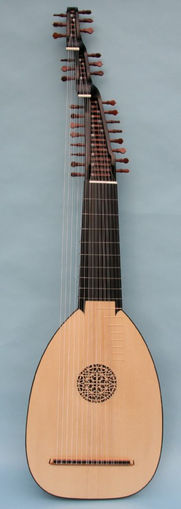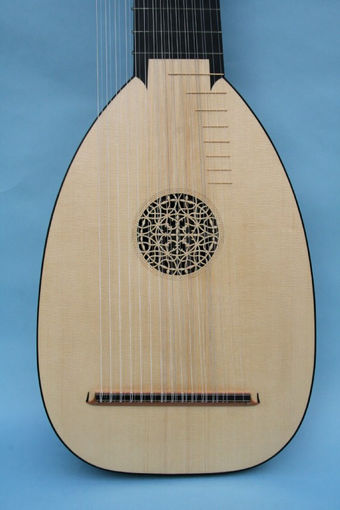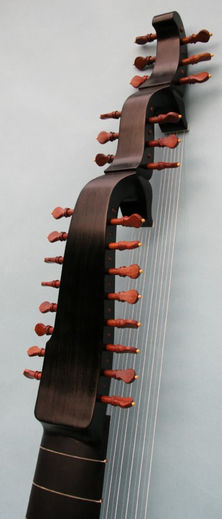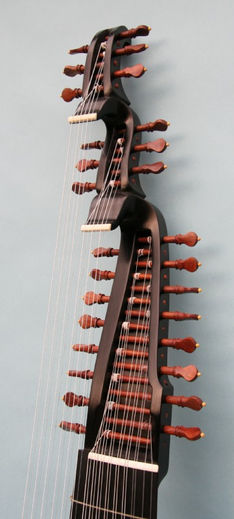Baroque Lutes
The baroque lute, in all its variants, is distinct from its Renaissance predecessor not only through its larger body and longer string length, but mainly through its unique d-minor tuning (the accord nouveau): f d a F D A, followed by a number of diatonic diapasons (open bass strings, tuned in octaves), that can be tuned according to the key of each piece. The addition of the bass strings produces a full and deep tone in the lower register as well as enriching the overall timbre through sympathetic vibration.
In regards to playing these instruments, while the longer string length might seem to create stretching problems for the left hand, the style of writing relies heavily on open strings and rarely calls for stretches. These are drastically different instruments compared to their Renaissance predecessors and represent a new musical style and a new technique for the lutenist.
The two main representatives of the Baroque lute, used in the performance of lute music written between 1650-1780s, are the 11 course and the 13 course lutes.
The most prolific and notable composer for the baroque lute was Silvius Leopold Weiss (1686-1750), a contemporary of J.S. Bach (1685-1750).
The 11 Course Lute
Chronologically, the 11 course lute was the first baroque lute, tuned in the newly established d minor tuning (accord nouveau) after several transitional experiments with various other tunings. A direct descendent of the 10 course lute, it was cleverly designed, keeping the same number of pegs by adding a treble rider to the peg box and using a single string second course, which was to become the norm for all future baroque lutes.
The 11 course lute, with a very distinctive character, was epitomized by the 17th century French composers - Dufaut, Gaultier, Mouton and Gallot - while being strongly present outside of France in the beautiful music of David Kellner, Esaias Reusner and J.G. Conradi.
Here is a lute based on my personal design with a string length of 67.5 cm. (For some pictures of the construction of this lute see the bottom of the Construction page).







The 13 Course Lute
The culmination of the lute’s historical evolution is the 13 course lute, with the same d minor tuning, developed and favored by the German lute composers of the 18th century. Through the practical ingenuity of the 17th and 18th century luthiers, the 11 course lute morphed into the 13 course by the addition of the Bass rider to the – already busy – peg box. The 11 course and 13 course lutes continued to coexist.
The inventiveness of the baroque lute makers brought about the creation of alternative peg box solutions such as the Swan Neck and the Triple Swan Neck (Jauch) inspired by the theorbo’s and archlute family’s extended peg boxes. Lutes with such extended peg boxes are often called “theorboed”. The longer diapasons thus obtained imparted a yet more distinctive sound quality on the Baroque lute.
Notable baroque lute makers were Joachim Tielke, Johann Christian Hoffman and Sebastian Schelle.
The 13 course is the baroque lute par excellence, employed in bringing to life the music of the great Weiss and Bach.
Models offered:
-
-11 or 13 Course lute after J. Tielke, Nurnberg Mus. 1696, 69 - 70cm Mensur, 9 ribs only.
-
-Small 11 Course lute, after J. Tielke Frankfurt Mus. 65 - 67cm Mensur.
-
-13 Course lute, Shallow body own design after Dieffopruchar/Edlinger ca. 1600, 69 - 72cm Mensur 11 ribs only






The Triple Swan Neck






The 14 and 15 Course Lutes
As can be seen throughout its history (namely, a course has been added approximately each quarter of a century), the lute’s whole evolution sprang from the need to adapt the instrument to the requirements of the newly created music. A particular case of such customization is the addition of a 14 th course tuned to G” deemed desirable for the performance of Bach’s Suite BWV 995 in G minor (as in Evangelina Mascardi’s CD with The Complete Works for Lute by J.S.Bach recorded on the Arcana label A529, 2022).
14C Swan Neck Baroque Lute 72.5103cm for Evangelina Mascardi.












Here below you may see other cases where a string or two were added without affecting the sonority or the basic concept of the instrument.
This 14 course baroque lute was specially built for Yasunori Imamura. It can also be heard on Yasunori’s recording of Weiss: Lute Sonatas Vol 2.






This 15 course baroque lute was specially built for John Schneiderman.






